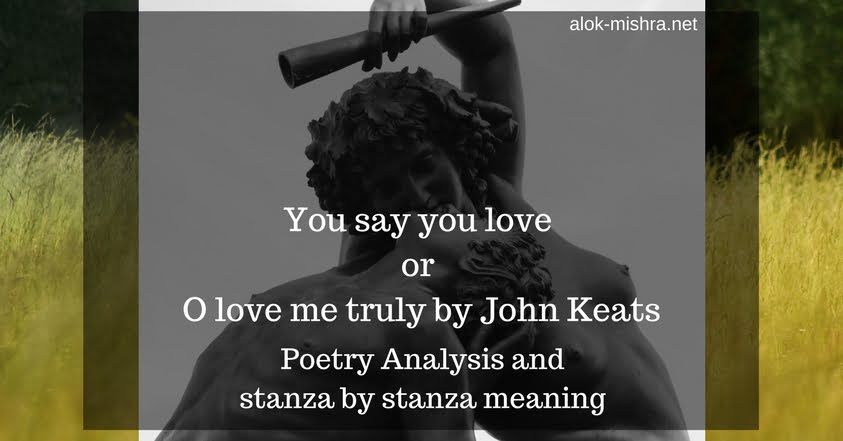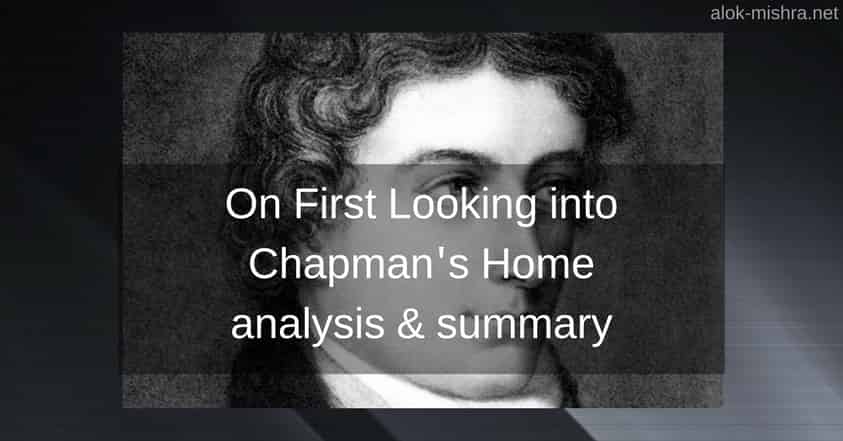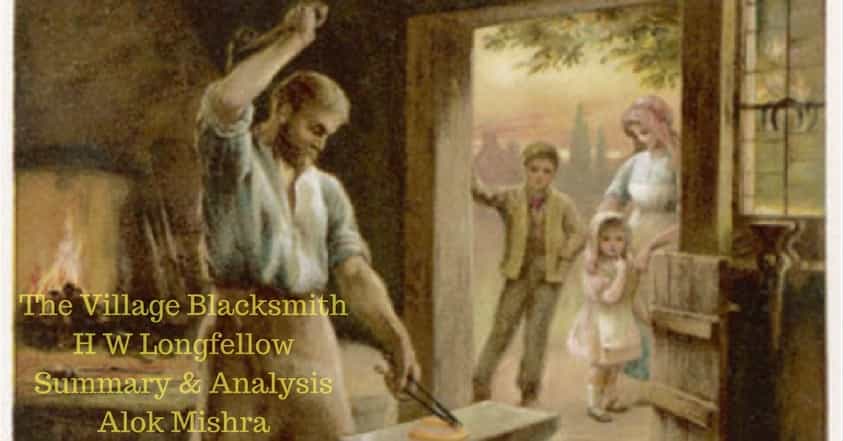On First Looking into Chapman's Homer is a very famous sonnet written by the celebrated…
You say you love; but with a voice – John Keats – Poetry Analysis
“You say you love; but with a voice” is a love poem by John Keats which is believed to be composed in the year 1817 most probably while some scholars also claim that the year may well be 1818. There might be reservations and speculations about the composition year of the poem but there is no ambiguity whatsoever that this is a love poem by John Keats probably addressed to his beloved who isn’t ready to ‘love him’ truly. By ‘loving him,’ the beloved must shower her indulgence in touching, kissing and looking at her lover with equal ‘fire’ and ‘passion’ with which the poet showers love on her. “You say you love; but with a voice” is a poem which can also be seen as a love poem in which the lover demands to be loved and it will (sometimes) take you to the metaphysical masters like Andrew Marvell who marvelled the art of demanding love poem which he addressed to his ‘coy mistress’.

In this article, I will try to analyse this poem by John Keats and will also paraphrase it for the readers and students who have to study this poem in their syllabus. Moreover, I am sure this article will equally be useful for them who just love reading poems and also understanding that what’s really there in the poem. So, let’s get started on this – You say you love; but with a voice by John Keats.
Paraphrasing: I will go stanza by stanza and simplify the poem in the lines which will try to gather the meanings in each stanza. There are twenty-five lines in the poem which are divided into five stanzas of five lines each. We will go one by one to decrypt the stanzas and then we will get into the analysis of the poem as a whole.
Stanza I:
You say you love; but with a voice
Chaster than a nun’s, who singeth
The soft Vespers to herself
While the chime-bell ringeth –
O love me truly!
As the lines suggest, there is no hidden meaning. The poet is directly involved and he is talking to his beloved (it’s the best possible assumption according to me). John Keats complains that his beloved lacks the warmth in her voice and out of fear or because of any other reasons, her voice is resembling the voice of a nun who sings in a low voice during the evening prayers in the church. Her urges his beloved to love him truly.
Stanza II:
You say you love; but with a smile
Cold as sunrise in September,
As you were Saint Cupid’s nun,
And kept his weeks of Ember.
O love me truly!
In the second stanza of the poem also known as O love me truly by John Keats, the poet is extending his arguments on why he thinks that his beloved is not loving her truly. He finds that the smile of his beloved is cold enough to be compared with the weather in September which is cold and the Sun also does not offer the warmth. He compares his beloved to the nun of Saint Cupid which is rather a metaphorical allusion because Cupid is rather known and actually is the symbol of love, erotic love and desire. He is not a saint. And likewise, he believes that his beloved behaves like she is being a nun in the days of fasting and religious rites (weeks of Ember) worshipping Cupid as a saint and not as a God of love! The refrain comes again – O love me truly.
Stanza III:
You say you love – but then your lips
Coral tinted teach no blisses.
More than coral in the sea –
They never pout for kisses –
O love me truly!
In the third stanza, John Keats writes with even more passion and compares his beloved to the coral in the sea which never moves and sits still. The lips of his beloved are absolutely beautiful but as the poet is unable to find them eager to be kissed, he is sad and tells his beloved that they are more like stationary corals who can never pout for kisses. Emotions are stronger in this stanza and it also ends with the refrain – O love me truly!
Stanza IV:
You say you love; but then your hand
No soft squeeze for squeeze returneth,
It is like a statue’s dead –
While mine to passion burneth –
O love me truly!
The fourth stanza reveals itself as well as reveals the poet’s ‘burning passion’. When the poet finds that his beloved does respond to his ‘soft squeeze’ to her hand, he is bewildered and compares her to the statue with no life in it. He lets his beloved know of the passion that he has inside and which burns unlike her beloved’s which is just not there. He again reminds her to live him truly.
Stanza V:
O breathe a word or two of fire!
Smile, as if those words should burn be,
Squeeze as lovers should – O kiss
And in thy heart inurn me!
O love me truly!
In the last stanza of the poem “You say you love,” Keats’ can easily be felt breathing in his passion and breathing out his words of beauty! He pleads to his beloved to be passionate in love and also in lovemaking when she should be. He requests her to smile, squeeze as lovers, kiss and also to bury him inside her heart as if they are one. And it ends with the refrain O love me truly.
Analysis of the poem:
The readers who know John Keats must know that he was a passionate lover and he loved his beloved Fanny Brawne more than anything else and people even believe that his excessive passion was the cause of many of his best poems known to the readers. This poem, probably composed in the initial days of his love affair with Fanny, seems to be urging her to indulge in passionate and erotic love with the poet. The charms of physical pleasures are demanded because Keats (in the poem) believes that Fanny is being either too shy or too modest which is unlikely in a love relationship. He wants to kiss his beloved and in return, wants to be kissed as well. As I said earlier, the poem can be compared to the one by Andre Marvell in which he urges his beloved to get out of her coyness and indulge in the game of love with him. However, the images of comparison that Keats draws in this poem are rather different. Comparisons like a dead statue, saint Cupid’s nun, coral in the sea and nun are something which persuades the readers to believe that Keats’ situation would have been in so much of frustration or despair. The images are either too negative or too seamy unlike the images of direct comparison in the Marvell’s poem which were lively and mostly the brighter ones or at least, good ones.
After all, the poem “You say you love” is a powerful love poem charged with the passion of the poet and eager to penetrate the heart of the readers. Well, if you also love someone, you must anticipate for the response in the same order if your beloved says that she loves you too.
Below are some useful links to the information that you would probably like to explore! Also, if you love reading John Keats, you can buy the collection of his poems (all the poems), Wordsworth Classic Edition, from the Amazon link below:




Wonderful! I was looking for an explanation of this poem that could help me understand as well learn more about the technical aspects of Keats’ poetry. This analysis worked the best! Thanks a lot!
It gives way to go into the depth of this beautiful creation of Keats. Excellent Alok!
Very helpful for me. I was wondering about some hidden meanings in the poem but you are right. There is just what we see in the lines. Comparison part is indeed interesting. Thanks